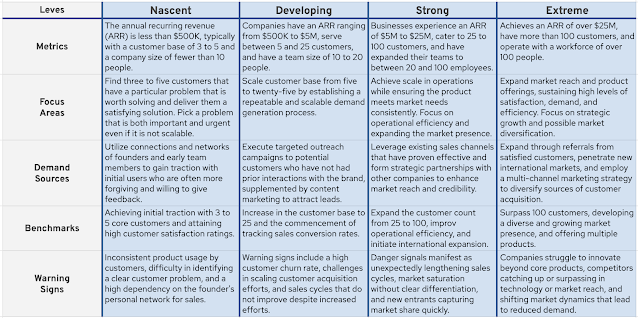Finding product-market fit (PMF) is arguably the most critical challenge faced by startups. Navigating the path to PMF can often feel like moving through a labyrinth, with each turn posing potential setbacks or breakthroughs. The PMF framework is designed to guide startups through the various stages of validating and scaling their product in the market. It helps founders identify where they are in the product-market fit journey, what their immediate focus should be, and how to recognize if they are on the right track or if adjustments are needed. The PMF framework is divided into four distinct levels, each representing a stage in a startup's lifecycle:
Nascent: Focus on identifying a critical problem and delivering a solution that is deeply satisfying to a small group of customers.
Developing: Transition from initial traction to a scalable business model by increasing the customer base and establishing reliable demand generation processes.
Strong: Scale business operations efficiently while maintaining product quality that meets market demands.
Extreme: Achieve widespread market acceptance, continuously optimize the product offerings, and explore new market opportunities for further expansion.
The table below provides a look at each level, featuring key characteristics such as company and financial metrics, primary focus areas, benchmarks for measuring progress, and danger signals that might indicate potential issues.
Product-Market Fit Framework Summary (click to enlarge) |
Navigating it means you've successfully developed a product that meets a substantial market demand and is capable of sustaining growth. Achieving PMF is not a one-time activity but an ongoing process that involves three dimensions: Satisfaction, Demand, and Efficiency. These dimensions evolve over the lifetime of a startup, each taking precedence at different stages of the company's growth.
- Satisfaction: In the early stages, ensuring customer satisfaction is paramount. Founders must concentrate on solving a critical problem that is important and urgent for a select group of customers. This involves creating a product or service that not only addresses the problem effectively but also delivers a superior experience compared to existing solutions. As startups move to higher levels of PMF, maintaining satisfaction remains crucial but becomes part of a broader strategy that includes scaling and optimizing operations
- Demand: As a startup transitions from the nascent to the developing stage, the focus shifts towards generating and scaling demand. At this point, the product or service has been validated with an initial customer base, and the challenge becomes attracting a larger audience. This involves fine-tuning marketing strategies, diversifying channels, and increasing market outreach to capture a broader segment of potential customers. Successful demand generation is marked by an increasing customer base and the establishment of repeatable sales processes.
- Efficiency: In the later stages of PMF, particularly when a startup reaches strong and extreme levels, efficiency becomes a critical focus. At these stages, the startup must optimize its operations to handle the scaling business effectively. This includes streamlining processes, reducing costs, improving operational throughput, and leveraging technology to enhance productivity. Efficiency gains are crucial for sustaining growth at scale, managing large teams, and expanding to new markets without compromising on quality or customer satisfaction.
 |
Focus areas during the stage in a startup's lifecycle (click to enlarge) |
The PMF framework is not a roadmap; it's a diagnostic tool that helps founders make strategic decisions and pivot when necessary, ensuring they stay aligned with market needs and business objectives. Through these evolving focus areas, the PMF framework not only helps startups understand what is required at each stage but also prepares them to anticipate changes in focus as they grow.
This amazing framework was thoroughly outlined by Todd Jackson during a session on Lenny's Product Growth Podcast. Impressed by the depth and practicality of the discussion, I felt compelled to distill and document the key points to better understand and apply these principles. For a comprehensive exploration of the PMF Method and to hear from Todd Jackson himself, visit Lenny's Newsletter for the full episode. Todd's expertise and clarity in presenting this framework make it an extremely useful resource for any startup looking to navigate the complex journey to market fit.









0 comments:
Post a Comment